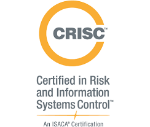(301) 220 2802
ISACA's Certified in Risk and Information Systems Control certification (CRISC) is designed to accredit IT professionals with hands-on experience identifying, assessing, and evaluating risk. Certification shows that you not only understand the risk but that you can help organizations accomplish business objectives by designing, implementing, monitoring and maintaining risk-based, efficient and effective IS controls.
TrainACE's hands-on training will prepare you for the exam as well as ensure you have practical experience in apply your knowledge to real-world situations. Our CRISC training in Metro DC are taught by ISACA certified professionals who will guide you through the training and certification process.
Got Questions?
For more information about your specific needs, call us at (301) 220 2802 or complete the form below:
Learn More About CRISC training in DC
Jump To:
Why Take CRISC Training?
The Certified in Risk and Information Systems Control certification (CRISC, pronounced “see-risk”) is designed for IT professionals who have hands-on experience with risk identification, assessment, and evaluation; risk response; risk monitoring; IS control design and implementation; and IS control monitoring and maintenance. The CRISC designation will not only certify professionals who have knowledge and experience identifying and evaluating entity-specific risk, but also aid them in helping enterprises accomplish business objectives by designing, implementing, monitoring and maintaining risk-based, efficient and effective IS controls.
CRISC Certification Training in Maryland, Washington DC or Northern Virginia
Our classroom based Certified in Risk and Information Systems Control (CRISC) certification training class is a hands-on and awesome experiential class that is designed to help folks pass the certification exam. Our training facilities reside at our two locations in the Washington, D.C. metro area: Ashburn, VA and Greenbelt, MD. We combine our labs with a superior certification exam preparation model to make for an awesome classroom experience for this new Cyber Security
What is the CRISC Certification?
The Certified in Risk and Information Systems Control (CRISC) credential is offered by the ISACA, a nonprofit association that advocates for information security professionals and offers various certifications that are globally recognizable and well sought after. The CRISC certification is unique because it covers subject matter that isn’t included in any other certifications. The certification ensures that candidates are prepared to mitigate the challenges of IT and risk management. It demonstrates that they are positioned to become strategic partners to the organization.
Candidates who want to take the CRISC certification exam must be able to prove that they have at least three years of work experience in IT risk and information systems control. They must have worked in two of the CRISC domains during that time, with one being either Risk Identification or Risk Assessment.
What is the CRISC Exam Like?
The CRISC certification exam covers four domains. These domains and how they are weighted on the exam are:
- • Risk Identification – 27%
- • Risk Assessment – 28%
- • Risk Response and Mitigation – 23%
- • Risk and Control Monitoring and Reporting – 22%
The CRISC certification exam consists of 150 multiple-choice questions for which candidates have four hours to complete. The exams are given during two testing windows throughout the year, for which candidates must register on the ISACA website. In the Washington, D.C. area, there are more than a hundred testing centers where candidates can take the CRISC exam, so finding one that is convenient shouldn’t be difficult.
Why Get a CRISC Certification in Washington, DC?
The CRISC certification is one that can help advance the careers of those who hold it. Because the CRISC is the only ISACA certification that covers IT risk management and mitigation, candidates who hold the certification are often sought-after individuals.
Technology is perhaps the most critical risk factor for most organizations today. Combining that fact along with the fact that many IT professionals lack knowledge in IT risk management, and it’s easy to see why becoming a CRISC certified professional is beneficial. It will likely help place credential-holding candidates above their non-certified counterparts for career advancement and new job opportunities in DC, Maryland, or Virginia.
Additionally, attaining the CRISC certification in Washington, DC and surrounding areas can help individuals earn a good living. The average salary in metro Washington, DC for CRISC certified professionals is $113,437.
Who needs CRISC Certification?
IT professionals interested in earning Certified in Risk and Information Systems Controls (CRISC) certification. CRISC is for IT professionals, risk professionals, business analysts, project manager and/or compliance professionals, how work towards evaluation and mitigation of risk, and who have job experience in the following areas:
- Risk identification, assessment and evaluation;
- Risk response and monitoring and
- IS control design/monitoring and implementation/maintenance.
Related Careers:
- Director of Information Security
- Information Security Officer
- Information Security Manager
- Information Security Analyst
What will I learn in this CRISC class?
CRISC is all about demonstrating an individuals ability to identify, assess, and manage an organizations information technology risk. During our CRISC class, you will learn about the four main areas of this critical business domains:
1. IDENTIFYING IT RISK
You will learn to recognize and assess threats to organizations IT eco-system, it's people, it's process and technology. Proven expertize in this domain validates your ability to play your part in implementing the organizations Enterprise Risk Management strategy (ERM) in line with its business objectives.
2. ASSESSING IT RISK
We'll give you a deep understanding of how to evaluate IT risks and the probability of their occurrence, as well as understanding their impact on the business. This domain teaches you advanced skills in identifying organizations risk exposure and the ability of the organization to handle those risks effectively.
3. RISK RESPONSE AND MITIGATION
In this critical domain, you'll be guided through the process of evaluating and implementing risk responses while continuing to assess their efficiency and effectiveness. Understanding this domain demonstrates your ability to select appropriate risk responses that are closely aligned to an organization's goals. It ensures you understand the importance of effective communication of those responses and your ability to monitor their effectiveness and adjust as necessary.
4. RISK AND CONTROL MONITORING AND REPORTING
Once you understand how to identify and respond to IT-related risks, we'll teach you how to maintain a risk-aware environment within your organization. This domain covers skills associated with continuous monitoring and reporting IT risks to relevant stakeholders. In doing so, you will ensure that your strategies are closely aligned with the overall business goals and processes. In this domain, you will learn how to define and implement Key Risk Indicators (KRIs) based on available information, enabling continuous monitoring of changes in the risk environment.


